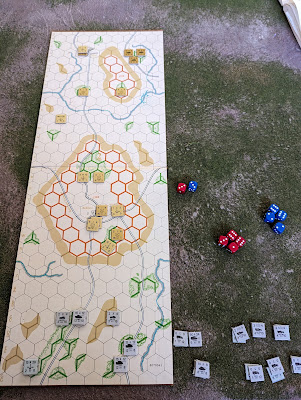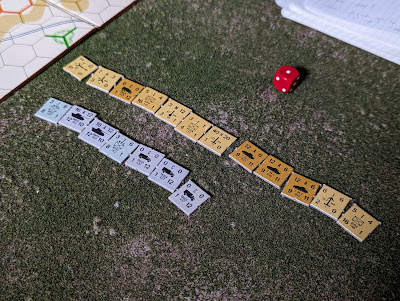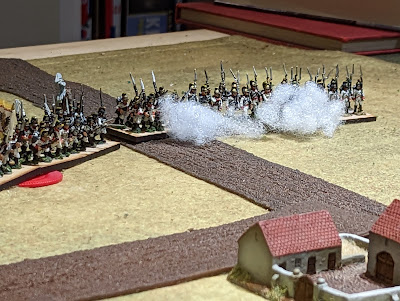The very name Panzerblitz has always evoked a certain nostalgia with me - being one of the first board wargames I ever owned that was not an operational or strategic level game, Panzerblitz had me leading the Panzer platoons and T-34 companies during the Kursk operation and making tactical decisions that could determine the outcome of the larger battle. At that time in my life I was preparing for entrance into military school and eventual commissioning as a Second Lieutenant, so tactical games like Panzerblitz and Squad Leader served as more than mere diversions - they were a way to hone my trade.
 |
| Still a classic |
Given the sentimental nature of these rules and their importance to me, I could never bring myself to part with them. Rather than throw away, sell, or trade, I lovingly wrapped them up and put them in the attic, all the while hoping to "one day" return to them.
Playing in Bryan L's outstanding "Kasserine Pass" game last week, I was struck at the elegance and simplicity of Bryan's Frankenstein combat system. While he still utilized the attack, defense, and indirect attack values of the counters (leaving the designer's crucial work of identifying combat values for battalions and regiments intact) Bryan "bolted on" the Axis and Allies board game combat system whereby if an American infantry Battalion counter had an attack/defense/move value of 3/4/7 in Kasserine Pass, Bryan allowed that unit to attack with D10 equal to the number of minis still in the unit (most had 4 reducing the unit by 1 for each unsaved hit), aiming to hit with a 3 or less, subject to a few very simple modifiers. Artillery could increase this To-Hit value by the amount. If that same unit's hex was being assaulted, the defense value would be 4 or less, again with the artillery adding to the overall score. This was genius, and so glaringly simple I was almost embarrassed I hadn't thought of it sooner. Even while I was still losing as the Americans, I was thinking about Panzerblitz and Arab Israeli Wars from Avalon Hill up in my attic. While I wouldn't use the exact same system as Bryan, I was crafting a similar idea.
 |
| Defending Wadi Sbeitla with 2 x Infantry Battalions and an Armor Battalion |
Recall last winter's multiple posts on GDW's "First Battle" series and the combat results table being "disassembled" to be played a bit more like a miniatures game. My result, while working fine, still felt like a board game. And the more I played it, the more I realized "A Fistful of TOWS" owed much to the GDW Team Yankee design. So that experiment didnt "take off" quite like I had hoped. Sometime last year, Ken and I had played Lock and Load's "World at War 85" game which really felt like a miniatures game. Why? Simple - because the units had "To Hit" attack values with dice based on the scale of their capabilities. A unit equipped with good tank guns might roll 3 or 4 attack dice aiming for a 4+ or 5+ to score multiple hits. A target unit with good armor, would have similarly good save values. The game really worked! And it didn't feel like a board game at all. It felt like a minis game being played with counters. So much so that I bought a 2" hex mat to play WaW85 in miniature with my microarmor.
A New Take on Older Boardgames?
Taking Panzerblitz into consideration, I looked at the combat results table and wondered how I could "miniaturize" it without breaking anything. While not a perfect concept, I liked the idea of opposed "successes" somewhat similar to the Lock and Load system. While my goal wasnt necessarily to make the CRT "chartless", I may have stumbled that way anyways...
The original CRT has 4 potential outcomes ranging from "-" which we'll call "NO EVENT" up to "D" or Disrupted, "DD" or Double Disrupted" or "E" for eliminated. The CRT, like most, uses a comparison of attack strength to defense strength, and a D6 to arrive at a conclusion from this round of combat between units. For more reading on CRTs, check out this excellent blog
post by "Chuck" from his blog "Gaming with Chuck."
Anyways, since the units are platoons to companies of tanks or troops, it's easier to abstract this. Jim Dunnigan obviously did his homework from WWII and used the best data he had access to, and so I'll use the stats straight from the box.
My thoughts were to have opposed die rolls (D6) with somehow maintaining the combat ratio and the combat values. The answer to the problem lies with the unit Attack and Defense values. Let's take an engagement in the open at a standard range (not close or long).
 |
| Custom PB Panther counter taken from Wargame Vault seller "Homeland Workshop" - used without permission - but you should definitely go there and buy their work if you like this counter. |
The attacking Panther platoon has a basic unmodified attack strength of "16". Dividing that by "3" we get "5" attack dice.
 |
| T-34 counter taken from Wargame Vault seller "Homeland Workshop" - again used without permission |
The defending T-34 platoon (or company?) has a basic, unmodified defense strength of "9". Dividing by "3" we get "3" defense dice.
So the German player rolls 5D6, looking for 4+ "Successes". The Russian player rolls 3D6, looking for 4+ "Successes". With the desired outcomes for both of the players to score as many successes as they reasonably can.
If the German player can achieve 3 "unanswered" successes, he eliminates the Russian unit. If he can achieve 2 "unanswered" successes, he "double disrupts" the Russian unit. Finally, if he scores a single "unanswered" success, the "disrupts" the Russian unit.
So the basic combat exchange in this scenario looks like this:
Norm rolls 5D6 and scores 5 "successes" with every die rolling 4 or better. Jeffers rolls 3D6 and scores 3 "successes" with every die rolling 4 or better. In the final comparison, Norm has beat Jeffers by 2 successes. So Jeffers' T-34 platoon is "Double Disrupted". He puts some kind of counter or marker on the unit to show its status. If Jeffers would have rolled 1 less success, his T-34 platoon would have been eliminated. Norm could not have rolled any better than 5 successes, and with Jeffers rolling all of his successes, he staves off an "elimination" result.
The same rules from Panzerblitz on combining attacks, single attacks, etc apply. So Jeffers could mass all of his platoons next turn against Norm's Panther platoon.
What about when the numbers aren't clean?
I have been rounding all of my results down in instances where the combat values are not evenly divisible by 3. So for instance, a defense value of "7" with a remainder of 1 has 2 x dice. The WEC or "Weapons Effectiveness Chart" still doubles, halves etc the combat values when necessary and to this you can apply the dice based on the new combat value.
So are you really going to roll 20 dice for a howitzer attacking an infantry unit?
In the cases of indirect fire, I'm going to use a simple table taken from Dan Fraser's Panzerblitz in Miniature or just use the CRT from the game itself. That said, when a howitzer is used for direct fire against a dig in infantry unit, then yes, it will be rolled like a normal attack.
What About Terrain Limitations?
I'm going to apply -1 to the attacker's dice. So in the above example, Norm would only have rolled 4D6 and not 5 due to the terrain. In certain circumstances with terrain, you have to use all of the defenders' defense strengths together, in which case it will make assaulting a town or village that much more difficult. Haven't tried that yet but I will. If the Terrain Effects Chart (TEC) says to reduce AF by half, then I will halve the Attack Factors, then I will calculate the dice.
 |
| Terrain Effects Chart from Panzerblitz |
This is all well and good but how does it shake out in a "real world" or "real game" example? Jeffers is never going to put an infantry unit in the open - sly gamer that he is.
So let's say Norm's Panther (Attack Factor 16) is attacking Jeffer's infantry platoon who are dug-in in the woods. Looking at the WEC, Norm must halve his AF because he is attacking an infantry unit with an armored unit. 16-8=8. Jeffers' defense strength is "12". Norm's attack by fire is going to be reduced by a single 1D6 (remember minus 1D6 attacking a unit in the woods so Norm's poor Panther platoon must make due). Jeffers is going to roll 4D6 against Norm's attack-by-fire. Norm rolls a single success, and Jeffers rolls 2 successes. No effect with the attack-by-fire.
Perhaps Norm would have been better off conducting an overrun attack with his Panther platoon? (not really because an overrun has to occur in clear terrain but for the sake of argument here let's see what happens):
In Panzerblitz conducting "overrun" attacks with armored units, you get a 1 column shift, and subtract 2 from the die roll (increasing the odds that you'll have an effect on the target). Norm's Panther with it's attack value of "16" garners 5 attack dice. In this instance, Jeffers' infantry platoon defense is "12" which gives him 4 defense dice. The column shift gives Norm an extra D6, and the -2 on the die roll gives Norm another D6. This brings Norm's total dice rolled to 7 against Jeffers' 4. Norm could do alot of damage with 7 dice! Here's hoping Jeffers rolls low!
What's Next?
Clearly this isn't perfected yet and there are some rules to still comb through (close assault rules, sequence of play, rallying, etc) but I think I'm on to something here. The newer version of Panzerblitz "Hill of Death" has a neat random activation system in it and I'm going to tinker with that a bit as well to see if you use an asymmetric turn sequence or a more predictable turn sequence with a set attacker and a defender.
So I still have some work to do in terms of ironing everything out and coming up with solid "rules" for how things work, but my gut feeling is that this would work well for all of the WWII and modern tactical games I have where there are Attack, Defense, Range, and Movement values on the counters, and the game would have a distinctly "miniatures" feel to it, instead of purely a board game CRT ratio.
My next step is to play an actual game with Panzerblitz on the table to see how that goes. I plan on documenting the entire thing. My plan is to create a nice QRS that you can use to play these games with all of the Panzerblitz, Panzerleader, or Arab Israeli Wars counters and maps, or use miniatures. Technically, I feel that the numbers are solid to also use the GDW WW2 games such as "Blood and Thunder" or "Sands of War."
I hope this was an enjoyable read for everyone, and if you liked this, wait until you see what I've come up with for the old SPI "Napoleon at War" boardgame rules. It's a similar concept to the "roll successes" idea but with Napoleonic Brigades.
We'll still use the SPI Combat Results Table (which, BTW is similar for many of their larger scale Horse and Musket games such as the "Blue and Grey" series - so the potential is limitless for Napoleonic and ACW games) and I may take it a step further and try it out with Lobositz and the CRT from that old-but-good GDW game.
On the miniatures front, I'm prepping for an AWI Christmas Megagame using the "Live Free or Die" rules. Stay tuned! Lots of good gaming coming up!

















































